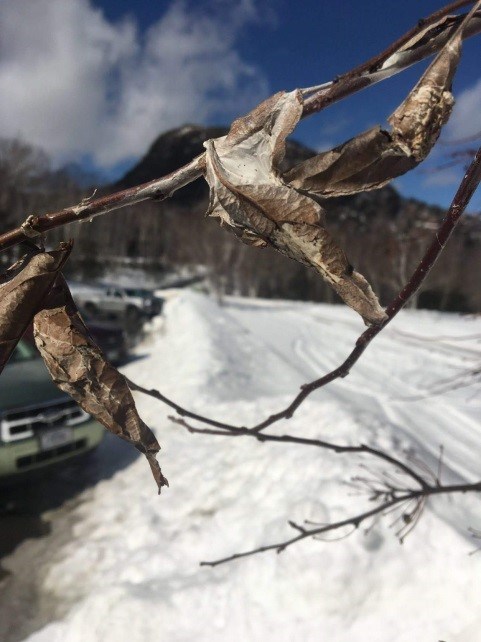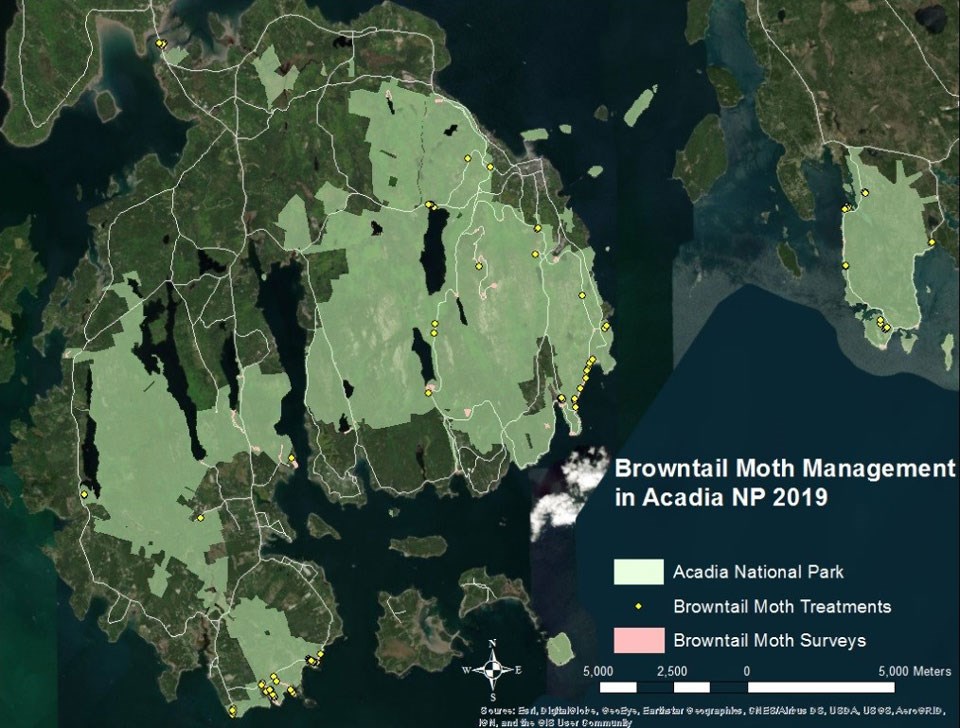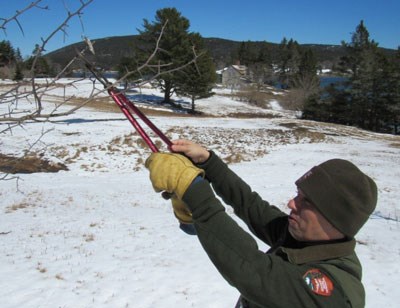Last updated: September 28, 2021
Article
Briefing Statement: Browntail Moth in Acadia

NPS Photo
April 24, 2019
Issue:
Browntail Moth (Euproctis chrysorrhea) caterpillars, now observed on Mount Desert Island and Schoodic Peninsula, have poisonous hairs that can inflict a nasty rash when outbreaks occur.
Concerns:
When moth hairs are shed and come in contact with human skin, it causes a rash similar to poison ivy.
People may also experience respiratory distress from inhaling the microscopic hairs that blow around in the air. The rash and trouble breathing can last a few hours to several weeks. The hairs remain toxic for up to three years so although the problem is worst from May to July, they may cause a reaction at other times of year.
Background:
Browntail moth, originally from Europe, was reported by a visitor on Great Head and confirmed by a Maine State entomologist in March, 2019. Browntail moth has been in Maine for over a hundred years and has gone through occasional outbreaks, but has become quite numerous along the mid-coast of Maine in recent years. The larval stage (caterpillar) feeds on the foliage of many hardwood tree and shrub species, particularly: apple, oak, serviceberry, hawthorn, and cherry. While defoliation causes some damage and occasional tree mortality, the primary human impact from the browntail moth is the result of contact with the tiny poisonous hairs found on the caterpillars.
Browntail moth caterpillars are dark brown with a white stripe on each side and two red dots on the back. In the spring, the 1.5 inch (3.8cm) long caterpillars leave their overwintering webs to feed on newly emerged leaves of their host plant. Caterpillars will form cocoons and adult moths emerge in late July and August. The snow white colored moths lay eggs and in the fall, colonies of caterpillars build 2-5 inch (5-10 cm) winter webs at the tips of branches (Figure 1). There can be 25-400 caterpillars overwintering in each web made of leaves and white silk.

Map: Acadia Exotic Plant Management Team
Current Status
After one web was confirmed in on a serviceberry on the Great Head Trail in 2019, Acadia staff surveyed high visitor use areas in the park, including picnic areas, parking lots and some popular trails. Resource management staff clipped and treated 141 webs from trees and shrubs among 29 different sites in the park (Fig. 2). So far in 2020, managers have removed slightly more webs than 2019 and have found more sites containing browntail moth. Still, the densities of webs in most areas are low enough that severe health issues are not likely. Most of the webs were attached to serviceberry, apple, white birch, choke cherry and red oak. Be on the lookout anywhere in Hancock County as browntail moths can spread to new areas on their own, with the wind, and as pupae attached to vehicles.

NPS Photo
Park Management Actions
When reachable with pole pruners, staff can clip the winter webs from tree branches and dispose of the caterpillars in soapy water (Figure 3). With low population levels, this management strategy can be effective at keeping the spread contained. Once populations increase, it becomes more difficult to prune all the webs found, leaving areas susceptible to browntail moth infestation. There is very little that can be done once caterpillars emerge out of their webs to feed on budding leaves.
Desired Public Actions:
Report suspicious webs at the tips of branches of host species—most reports of new invasive exotics come from concerned citizens. Avoid places heavily infested by caterpillars, take a cool shower and change clothes after coming in contact with hairs. Do not dry laundry outside during June and July to avoid hairs that blow on the wind onto your clothing. In heavily infested areas, wear a respirator, goggles, and coveralls when doing activities that stir up caterpillar hairs, like mowing. Contact a physician if you develop a severe reaction.
Additional Reference Materials:
- https://www.maine.gov/dacf/mfs/forest_health/insects/browntail_moth.htm
Contact Info:
Jesse Wheeler, Vegetation Program Manager; jesse_wheeler@nps.gov, 207-288-8722
